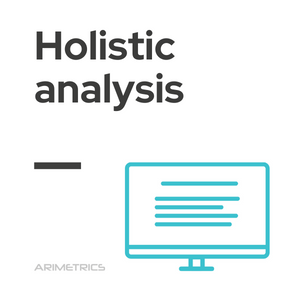
Definition:
The term holistic refers to an approach that considers entire systems rather than focusing solely on their individual parts. In the context of web analytics, a holistic analysis involves the collection and evaluation of all relevant data from a website, with the goal of gaining a holistic view of its performance.
This approach allows analysts and marketing teams to understand not only how different sections of a page function, but also how they interact with each other and affect user behavior as a whole. By taking a holistic view, the complexity of the user experience and site dynamics can be captured, providing valuable information for strategic decision making.
What holistic analysis is for
Holistic analysis enables organizations to approach their strategies from a holistic perspective, facilitating a deeper understanding of their operations and customer behavior:
- Identifying opportunities for improvement: By looking at all aspects of a system, companies can identify specific areas that require attention. This includes detecting bottlenecks in processes, friction points in the user experience, and opportunities to optimize overall performance.
- Developing personalized strategies: Holistic analytics allows companies to segment their audience more effectively. By understanding how different groups of users interact with their site, they can design more personalized and targeted marketing strategies, increasing the relevance of their campaigns.
- Trend forecasting: By analyzing data holistically, organizations can identify patterns and long-term trends. This allows them to anticipate changes in consumer behavior, adapt their offerings and stay one step ahead of the competition.
- Fostering interdepartmental collaboration: Holistic analytics promotes collaboration between different departments, such as marketing, sales and customer service. By sharing information and analytics, companies can work more cohesively toward common goals, improving communication and efficiency.
- Improved decision making: With a more complete understanding of data and its context, business leaders can make more informed and strategic decisions. This minimizes the risk of decisions based on fragmented or incomplete information.
- Assessing the impact of changes: When implementing new processes, campaigns or technologies, holistic analysis allows companies to assess the impact of these changes more effectively. This helps determine whether new initiatives are meeting established objectives and whether adjustments are needed.
- Resource optimization: With a clear and complete view of how resources are used, companies can optimize the allocation of resources, ensuring that they are used efficiently and effectively. This can result in significant savings and a better return on investment.
Holistic analysis process
The holistic analysis process takes place in several stages, each of which is relevant to gaining a complete understanding of a website’s performance. The key stages are described below:
- Data collection: The first step in holistic analysis is to identify and collect data of interest from multiple sources. This may include website traffic data, user interactions, conversion metrics, social media, and more. It is essential to determine where this data is located and how it can be collected effectively.
- Data integration: Once the information has been collected, it is essential to develop an integration strategy that ensures data consistency and quality. This involves consolidating data from different sources into a unified format, which facilitates subsequent analysis.
- Data presentation: The way data is presented is important for identifying relevant trends and metrics. Dashboards and data visualizations are particularly useful tools in this phase, as they allow analysts to observe patterns and results in a clear and understandable way.
- Data interpretation: Data analysis should be agile and accessible. Although in some cases it may be necessary to dig deeper into the data to obtain more detailed information, it is important that the insights are easy to understand and applicable to the marketing strategy.
- Data maintenance: For data to be useful in the long term, it is essential to maintain its quality and consistency. This involves conducting periodic reviews, updating information as needed, and ensuring that the data remains relevant for future decisions.
Advantages of holistic analysis
Holistic analysis offers numerous advantages for companies and their marketing strategies:
- Holistic view: By considering all available touch points and data, a more complete view of return on investment (ROI) and the activities that drive growth is obtained. This allows companies to identify which tactics are most effective and where they should focus their efforts.
- Understanding customer behavior: This approach allows companies to better understand their customers’ behavior, which in turn helps predict what drives them to engage with the brand. By analyzing how users interact with the site and different channels, opportunities to improve the customer experience can be identified.
- Informed decision making: With a holistic view, analysts and decision makers can base their strategies on comprehensive and consistent data, reducing uncertainty and improving the effectiveness of marketing initiatives.
- Adaptability and scalability: By establishing analysis processes that consider the whole, companies can more easily adapt to changes in the market and scale their operations effectively. This approach also allows organizations to be more proactive rather than reactive.
